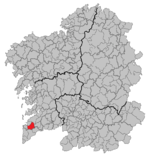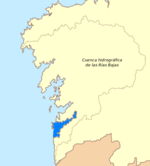Nigrán
Galicia (Spain) geography stubsMunicipalities in the Province of Pontevedra

Nigrán is a municipality in the province of Pontevedra, in the autonomous community of Galicia, northwestern Spain. It belongs to the comarca of Vigo and the Vigo metropolitan area. Nigrán has a surface of 35 km2, with a population of approximately 18,000 people divided into seven parishes: Nigrán, Panxón, San Pedro, Parada, Camos, Chandebrito and Priegue. Nigran's population practically triples in the summer months. It is on the Atlantic coast of Spain and is considered a summer destination for tourists due to its beaches and mild summer weather.
Excerpt from the Wikipedia article Nigrán (License: CC BY-SA 3.0, Authors, Images).Nigrán
Nigrán
Geographical coordinates (GPS) Address Nearby Places Show on map
Geographical coordinates (GPS)
| Latitude | Longitude |
|---|---|
| N 42.141944444444 ° | E -8.8055555555556 ° |
Address
36350 Nigrán
Galicia, Spain
Open on Google Maps









